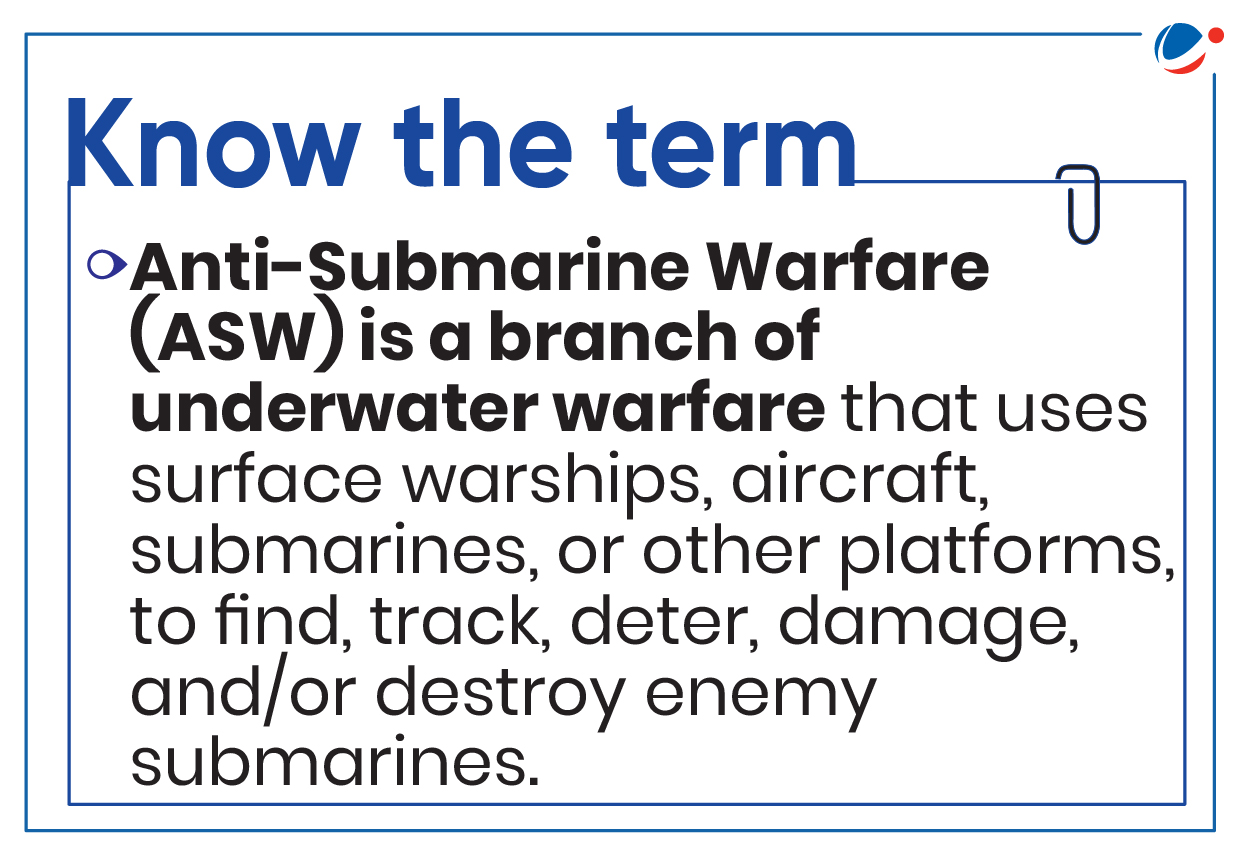Why in the news?
Defence Research and Development Organisation (DRDO) conducted a successful flight-test of Supersonic Missile-Assisted Release of Torpedo (SMART) system.
SMART System
- SMART is a next-generation missile-based light-weight torpedo delivery system to enhance the Anti-Submarine Warfare (ASW) capability of the Indian Navy.
- It has been designed and developed by DRDO.
- Components: This canister-based missile system consists of several advanced sub-systems, namely two-stage solid propulsion system, electromechanical actuator system, precision inertial navigation system etc.
- The system carries advanced light-weight torpedo as payload along with parachute-based release system.
- Significance: SMART system comprises a mechanism by which the torpedo is launched from a supersonic missile system taking it to a far longer range than its own.
- Torpedoes are self-propelled weapons that travel underwater to hit the target.

Submarines
- A submarine is a vessel, or ship, that can go underwater. Militaries and scientists use submarines to travel deep under the ocean.
- Unlike a ship, a submarine can control its buoyancy, thus allowing it to sink and surface at will.
- A submarine has huge tanks, called ballast tanks, that allow it to dive and to surface.
- To submerge, the submarine fills ballast tanks with water, increasing weight. To surface, water is released, and tanks fill with air, making the submarine buoyant enough to float.
- For power, submarines use engines, batteries, nuclear power sources, or a combination of these. Propellers push submarines through the water.
- Significance of Submarines
- National defence: Capable of operating for months from the deep, these are quieter and harder to detect, thus enabling critical defence and attack capabilities.
- Lethal capabilities: They can deploy a variety of lethal weapons such as mine laying on ports, shipping channels, targeting surface ships with torpedoes, usually without warning.
- Strategical advantage: It can also conduct reconnaissance, act as a barrier and provide advance warning of enemy movements.
- Nuclear Deterrence: In a conflict where adversaries launch a nuclear first strike on land and air-based assets, submarines guarantee a second-strike capability.
India's submarine force
Diesel-Electric Submarines |
|
Air Independent Propulsion (AIP) Submarines |
|
Nuclear Powered Submarines
|
|
India's ASW capabilities
- ASW Shallow Watercrafts (SWCs): Cochin Shipyard Limited is building eight ASW SWCs for Indian Navy, three of which have been launched namely, Mahe, Malvan, and Mangrol.
- Garden Reach Shipbuilders & Engineers (GRSE), Kolkata is building another eight ASW SWCs, six of which have been launched namely, Arnala, Androth, Anjadip, Amini, Agray and Akshay.
- Kamorta Class Ships: They are designed as the super-sophisticated frontline warships with Stealth features, having ASW capability with low signature of radiated underwater noise.
- India has four Kamorta-class corvettes (Project 28) namely, INS Kamorta, INS Kadmatt, INS Kiltan and INS Kavaratti.
- Integrated ASW Defence Suites (IADS): Ministry of Defence (MoD) has concluded a contract with Mahindra Defence Systems Limited for procurement of 14 IADS.
- IADS comes with an integrated capability for detecting enemy submarines and torpedoes at extended ranges as well as diverting incoming torpedoes fired by enemy submarines.
- Maritime patrol and reconnaissance aircraft: India operates 12 Boeing P-8I (Poseidon), which it bought from US to sharpen ASW capabilities.
- ASW helicopters: Indian Navy commissioned first squadron of newly inducted MH-60R Seahawk multi-role helicopters.
Challenges to India's submarine capabilities
- China challenge: China is increasing its naval presence in the Indian Ocean and has a large fleet of 78 submarines to support its expansion.
- China is also helping Pakistan acquire diesel-electric submarines.
- Resource constraints: Presently, India has only 16 submarines and resource allocation and prioritization of requirement remains the limiting factor.
- Age-old systems: Various submarines, airborne assets and corvettes need critical upgrade.
- There is emergence of new-age technologies for ASW such as Non-Acoustic ASW (detection of submarines via satellites).
- Non-acoustic submarine detection technologies are those that do not rely on the collection of soundwaves emitted or reflected by a submerged vehicle for location
- There is emergence of new-age technologies for ASW such as Non-Acoustic ASW (detection of submarines via satellites).
Way Forward
- New investments: Indian Navy should continue to invest in niche underwater warfare domains like imaging, sensing & navigation, AIP system, deep sea autonomous vessels etc.
- Indigenous development: DRDO and other defence research organizations should continue developing indigenous weapon systems and naval assets in collaboration with Indian defence industry.
- Collaborations: Indian Navy needs to continue its collaboration with other Indian Ocean littoral countries to augment its ASW capabilities and strengthen its presence.



